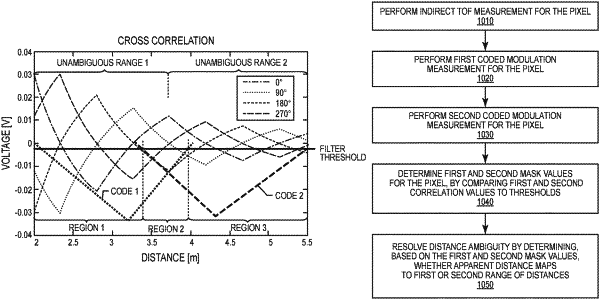| CPC G01S 17/89 (2013.01) [G01S 7/4808 (2013.01); G01S 17/36 (2013.01)] | 26 Claims |

|
1. A method for performing depth measurements with an image sensor, the method comprising, for each of at least one pixel:
performing an indirect time-of-flight measurement using the pixel, to obtain a value indicative of an apparent distance to an imaged object or scene;
performing a first coded-modulation measurement for the pixel to obtain a first correlation value, using a first combination of modulation code and reference signal selected to yield a first correlation response with a peak extending over a first range of distances to imaged objects;
performing a second coded-modulation measurement for the pixel to obtain a second correlation value, using a second combination of modulation code and reference signal selected to yield a second correlation response with a peak extending over at least a second range of distances to imaged objects, the second range of distances abutting the first range of distances, wherein the correlation peak for the second modulation code overlaps the correlation peak for the first code in an overlap region consisting of a portion of the first range of distances and an adjoining portion of the second range of distances;
determining a first mask value for the pixel by comparing the first correlation value to a first threshold and determining a second mask value for the pixel by comparing the second correlation value to a second threshold; and
resolving distance ambiguity in the value indicative of the apparent distance by determining, based on the first and second mask value values, whether the value indicative of the apparent distance corresponds to an actual distance within the first range of distances or within the second range of distances.
|